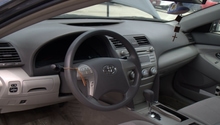Toyota Camry 1997-2001: Steering Diagnostic Guide
Steering issues in the Toyota Camry can affect the way the car drives and sounds. Read on to learn how to diagnose a steering issue.
This article applies to the Toyota Camry (1997-2001).
Steering issues in the Toyota Camry can not only ruin the driving experience, but it can also result in an accident. Any small steering or suspension components going bad will affect the way your car drives and feel. If you experience vibration in the steering wheel, grinding when going over bumps, or irregular bouncing, then you have a steering issue. In this article we will cover the potential culprits for the popular steering issues. Read on to learn how to diagnose it yourself.

Materials Needed
- Flashlight
- Jack and jack stands (optional)
Step 1 – Is steering wheel vibrating?
You may need to balance your tires.
Let's start with the basics and check our tires. An over-inflated tire will bulge in the center and the car will ride on the center of the tire tread. An under-inflated tire will balloon near the sidewalls, and have excess wear on the outside edges of the tire, near its "shoulder." If the tire is showing signs of cupping or becoming abnormally worn, as seen in the left-most image, it's likely an alignment issue, and the car requires an alignment check. Alternatively, if the tire has patchy, or intermittent bald spots, it's likely a worn suspension component causing the tire to have abnormal contact with the road surface, causing the poor wear.

Step 2 – Is car pulling in one direction?
You could have an alignment problem or a worn suspension.
If your car is pulling in one direction, then you're faced with a few things to inspect. The most common reason your car is pulling in one direction is because of uneven tire pressure. If this is your issue, then you're in luck. Most gas station have air pumps and you can find your proper PSI on the driver door jamb. Inflate them all evenly and properly.
If your car still pulls in one direction, it could be an alignment issue. Alignment can be discovered by uneven tire wear. There are DIYs out there for wheel alignment; however, it's recommended you do it at a tire shop. Their machines ensure accurate results.
If neither of these are the issue, then you could be faced with a worn or missing bushing. The most popular bushing that could cause your car to pull in one direction is the control arm bushings. Slide under the car and check all your bushings for cracks or wears. Also, if you hear any grinding noise when going over bumps, you're most likely faced with a worn suspension components, which could very likely be a missing bushing.

Step 3 – Is your car bouncy?
You may need to replace the shock absorbers.
A bouncy ride means unstable ride. If your car bounces around, it will cause you to swerve from one side to the next, and that is most likely due to worn shock absorbers. To check for worn shock absorbers, first inspect them for leaks, and if you are still unsure, go to one of the car's corners and push down on it. A car with good shocks will go down and back in place, but a car with worn shocks will continue to bounce once or twice after the initial push.

Step 4 – Does car change directions when you brake?
Your brakes could be dragging.
If your car goes to either sides when you brake, then you may have a brake issue and not a steering one. Simply inspect the brake pads for wear, rotors for wears, cracks, or rust, and inspect the caliper's pistons to see if they're sticking or not releasing. If your right caliper clamps on the rotors well but your left one fail to do so, the car will go towards the direction of the good caliper. Replace any worn or faulty brake components as fast as you can.

Related Discussions
- Steering Problem - CamryForums.com
- Vibration on Highway - CamryForums.com






